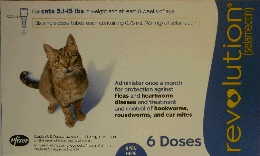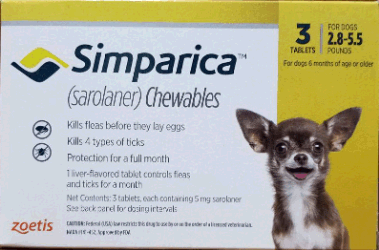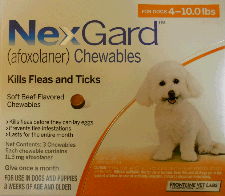|
EAR MITES

ANSWERING YOUR QUESTIONS ABOUT EAR MITES
(Otodectes cynotis)

(Photo Credit: Alan R. Walker via Wikimedia Commons)
Most people have heard of ear mites and know they are a common ear parasite of dogs and cats but that is where most people's knowledge of ear disease ends. In fact, inflamed ears have many potential causes and assuming the problem is ear mite infection can lead to weeks of the wrong treatment. Further, there are many treatments for ear mites, should they actually be the problem, and it is important to know that ear mite elimination no longer requires weeks of labor intensive, uncomfortable, oily topical therapy. We have assembled this FAQ to help explain the facts of ear mite infection, biology of the mite and treatment choices and pitfalls. We hope you find this information of use.
What are ear mites?
How did my pet get ear mites?
What harm comes from ear mite infection?
Is this contagious to me?
How do I get rid of ear mites?
What if they just don’t seem to ever go away?
WHAT ARE EAR MITES?
Ear mites are tiny infectious organisms resembling microscopic ticks. The mite can just barely be seen by the naked eye as a small white dot, though, ordinarily a microscopic examination of an ear wax sample is necessary to see it. Infection usually produces a characteristic dry black ear discharge commonly said to resemble coffee grounds. This discharge is composed of ear wax, blood, inflammatory biochemicals, and the ear mites themselves. Because the discharge is so classic in appearance, a diagnosis of ear mite infection is often made based on its presence. This leads to the potential to be led astray. It is best to examine the material under the microscope and confirm the presence of mites so that proper treatment can be instituted.
[Back to list of questions]
|
THE BIZARRE EAR MITE LIFE CYCLE
The mite lives on the surface of the ear canal skin, though sometimes migrates out onto the face and head of its host. Eggs are laid and hatch after 4 days of incubation. The larva hatches from the egg, feeds on ear wax and skin oils for about a week and then molts into a “protonymph,” which in turn molts into a “deutonymph.” The deutonymph mates with the adult male. What seems especially bizarre to us mammals, is the fact that the deutonymph has not yet developed a gender at the time it mates with the adult male.
After mating, the deutonymph molts into either an adult male or an adult female. If she becomes a female, she will be gravid with eggs as a result of the mating. If he develops into a male, there are no consequences to the mating and he is ready to mate with deutonymphs of his own choosing. The adult mite lives approximately two months happily eating ear wax and skin oils. The life cycle (the time it takes for an egg to develop into an adult mite ready for parenthood) requires 3 weeks.
|

Adult male mite mating
with a deutonymph.
|
Most ear mite cases are found in cats. Dogs can be infected as well but, since dogs more commonly get ear infections of other types, ear infections in dogs usually do not involve mites.
|
HOW DID MY PET GET EAR MITES?
Ear mites readily transmit from host to host by physical contact. Ear mites came from some other animal with whom your pet has been socializing. Because mites are easily transmissible by physical contact, treatment for mites must include all household pets. Dogs and cats spread mites readily to one another by physical contact.
[Back to list of questions]
|

(photocredit: MorgueFile.com)
|
WHAT HARM COMES FROM EAR MITE INFECTION?
The presence of the mites is very inflammatory and can generate very irritating ear infections. Skin disease can also result from infection by the ear mite.
[Back to list of questions]
IS THIS CONTAGIOUS TO ME?
Ear mite infection is certainly contagious among cats and dogs. Typically, the victim is an outdoor cat. Humans have been reported to develop skin rashes rarely; in general, we may consider that a human pet owner is extremely unlikely to experience any symptoms when their pet is infected with ear mites.
[Back to list of questions]
HOW DO I GET RID OF EAR MITES?
| SINGLE USE PRODUCTS |
|
|





|
There are currently several prescription products available that reliably eradicate an ear mite infection with one single use, though a thorough ear cleaning is still needed to remove the wax and debris from the ear. These products may be applied directly in the ear, to the pet's skin behind the shoulders, by injection, or orally.
The two current products that are applied directly in the ear canal are: Acarexx®, a topical version of ivermectin, and Milbemite®, a topical version of milbemycin oxime. These products are approved for cats only and are available only through veterinarians. A single dose should be all that is needed to clear the infection.
As for topical products that go behind the pet's shoulders, there are many parasite control products that can be used. Active ingredients such as selamectin, moxidectin, flurilaner, and saralaner typically remove an ear mite infection after a single dose. These products absorb through the skin and into the body where they remerge in the skin and ear secretions consumed by the mite. Mites are readily killed off by these treatments and, if they are used regularly, new ear mite infection is prevented. These products also kill fleas and sometimes ticks and intestinal worms depending on their formulation. They are designed for on-going use to control parasites. All of these products are prescription which means a recent veterinary visit is required to obtain them.
In dogs, there are presently four isoxazoline products available for oral use: Simparica® (sarolaner), Nexgard® (afoxalaner), Bravecto® (fluralaner), and Credelio®(lotilaner). For cats there is an oral formula of Credelio® (lotilaner). These are flea and tick products made for regular use but they will also eradicate an ear mite infection in a single dose.
|
|
INJECTION: TWO TO FOUR TREATMENTS
An older and not FDA-approved treatment, involves the use of ivermectin, a powerful anti-parasite medication. It is rarely used for ear mites as there are many FDA approved products nowadays but in certain circumstances it might be a good choice. Most ivermectin injectable protocols involve shots weekly or every two weeks. This is a highly effective method of ear mite eradication but there are some limitations. Certain breeds of dogs are sensitive to this medication and cannot take it. Certain individuals have similar sensitivities which cannot be predicted by breed. Injectable ivermectin is not approved for the treatment of ear mites in small animals. For safety reasons, it is probably better to employ one of the single-use products approved for use against ear mites.
|

(original graphic by marvistavet.com)
|
|

(original graphic by marvistavet.com)
|
TOPICAL TREATMENTS: AT LEAST TEN DAYS USAGE
Another approach involves the use of a prescription topical ear medication called Tresaderm® (manufactured by Boehringer Ingelheim) which contains an antibiotic for any secondary bacterial infections, a cortisone derivative for the inflammation, and thiabendazole to kill yeasts and mites. This is an excellent ear product and is able to kill the developing mite eggs. This cuts the treatment course down to 10-14 days and provides an excellent oily lubricant with which to clean the ears as well. This product has been favored by veterinarians for decades; still, it is no longer state of the art.
|
|
TOPICAL TREATMENTS: AT LEAST THREE WEEKS USAGE
Most older and over-the-counter products contain insecticides which do not kill incubating mite eggs. Because of this limitation, such products must be used for at least the duration of the 21 day life cycle of the mite. Some specialists recommend a 30 day treatment course with such products. While these products do work and are readily available at most pet supply stores, three weeks of use is relatively inconvenient and the pet may not always be cooperative.
|

(original graphic by marvistavet.com)
|
[Back to list of questions]
WHAT IF THEY JUST DON’T SEEM TO EVER GO AWAY?
Occasionally, we receive messages regarding a case of ear mites for which “everything” has been used and the mites simply will not go away. In this situation consider the following tips:
- Was the mite infection confirmed initially? Remember, it is easy to be fooled by the presence of a discharge that appears “mite typical.” This might not be an ear mite infection at all or perhaps it was in the beginning but is now a bacterial or fungal infection.
- Has the continuing mite infection been confirmed after therapy? Sometimes, a telltale hard bit of ear wax must be removed from the ear before comfort is finally achieved. Sometimes a bacterial infection remains though the mites are long gone. Treating for ear mites when none are present will not achieve results.
- Were all the hosts in the family treated? If all pets were not treated, begin again this time including all pets in the protocol. If all pets are not treated, they will simply re-infect each other.
- Consider using one of the new products. If you are trying to use one of the daily products, it is easy to accidentally skip a day here and there and foil your success.
[Back to list of questions]
Do not make the diagnosis of ear mite infection yourself. If you think your pet has an ear infection, see the vet for proper evaluation rather jumping straight to an over-the-counter remedy. You will need the right diagnosis before you can intelligently choose an ear treatment product.

Page last updated: 1/13/2023
|